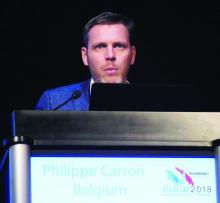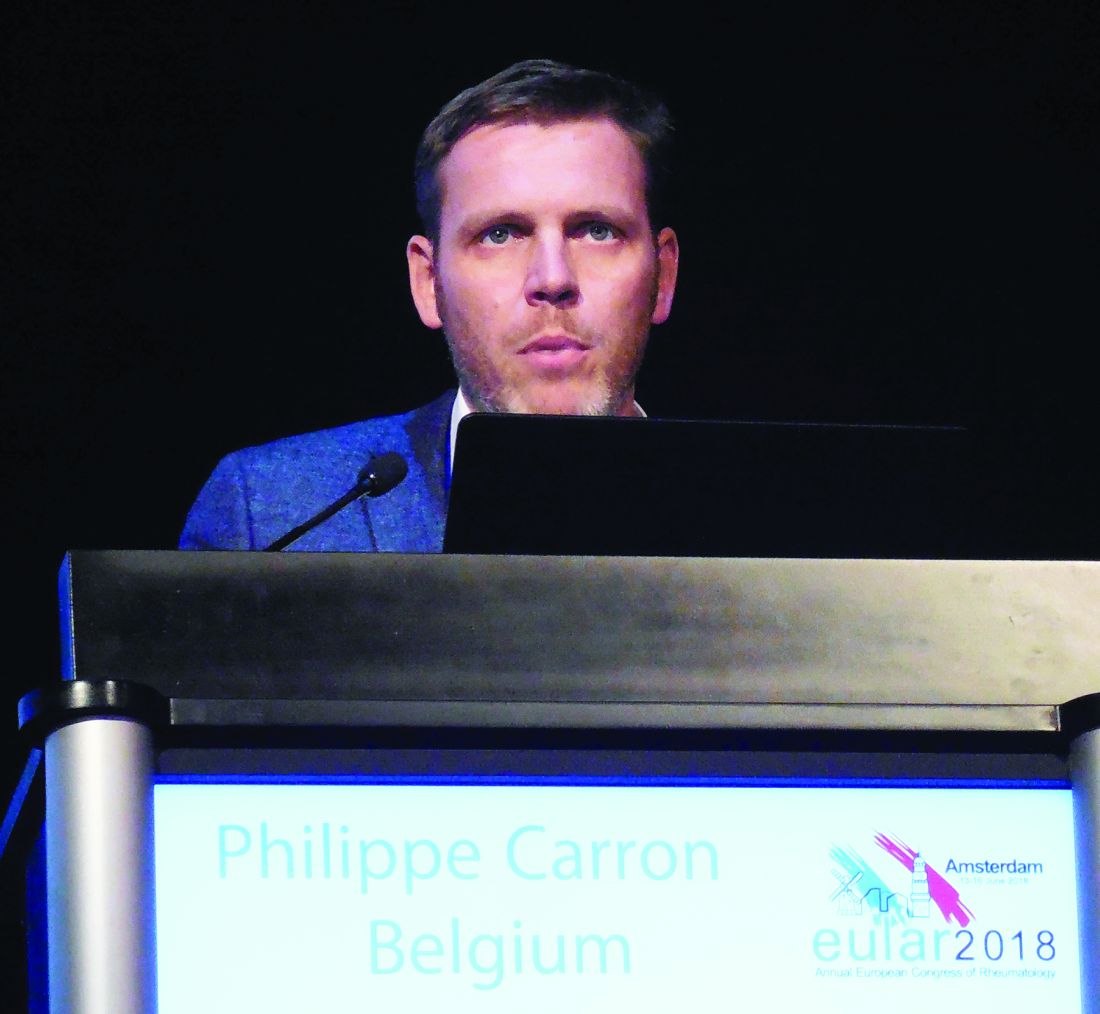User login
AMSTERDAM – Starting patients with newly diagnosed, peripheral spondyloarthritis (SpA) on treatment with a tumor necrosis factor (TNF) inhibitor within 12 weeks of symptom onset produced an “amazing,” long-term, complete remission that resembled cure in more than half of the 40 treated patients, a finding that now needs replication in a larger, multicenter study, Philippe Carron, MD, said at the European Congress of Rheumatology.
Ongoing research on patients in the original study cohort also showed that methotrexate is largely ineffective to help wean patients in remission on a tumor necrosis factor inhibitor off the biologic drug, said Dr. Carron, a rheumatologist at the University of Ghent (Belgium). In his group’s most recent experience with 22 patients in remission on a regimen of golimumab and methotrexate, 5 remained in remission (23%) when golimumab treatment stopped, whereas the other 17 patients had to restart golimumab (Simponi) while continuing on methotrexate after relapsing on methotrexate monotherapy, Dr. Carron reported.
Methotrexate has “overall weak efficacy for maintaining biological-free remission” in patients with peripheral SpA, he concluded.
But Dr. Carron remained very positive about the main finding of the CRESPA (Clinical Remission in Patients with Early Peripheral Spondyloarthritis) study, which has now shown a durable complete remission – free from arthritis, enthesitis, and dactylitis – in 21 of 40 (53%) patients who began golimumab treatment within 12 weeks of their symptom onset and then remained in remission when the golimumab was eventually stopped. These patients have now remained in complete remission for 2.4-5.8 years of follow-up, Dr. Carron said. He attributed this very durable remission while off any treatment to the rapid start of TNF-inhibitor therapy within weeks of their symptom onset.
“This is fantastic; these patients are cured. Early treatment is the most important reason why the result is so good,” but it also poses the biggest challenge for using this approach in routine practice, Dr. Carron said in an interview. “It took us 3 years to find the 60 patients” enrolled in CRESPA. “Most of the time, patients go elsewhere for treatment, and it’s several months until they see us. In many countries there are not enough rheumatologists, and patients wait 3, 4 months before we see them.” Another important feature of the intervention was that golimumab treatment continued until patients presented as completely symptom free on two consecutive clinic visits spaced about 12 weeks apart.
Dr. Carron and his associates published their initial findings from CRESPA in 2017 (Ann Rheum Dis. 2017 Aug;76[8]:1389-95), and they also have reported updates on the main results at meetings. At the 2018 EULAR Congress, Dr. Carron reported the outcomes of 31 patients in the study who entered a 2-year period of extended golimumab treatment either because they never reached complete remission or because they relapsed after stopping golimumab and so restarted the drug. Of these patients, 25 completed the full 2 years of the CRESPA extension phase on golimumab. Of those patients, 22 were in complete remission and agreed to continue; they began a tapering phase that started with receiving concurrent treatment with 15 mg/week of oral methotrexate then, after 12 weeks on methotrexate, discontinued their golimumab but continued on the methotrexate regimen.
After an average follow-up of 80 weeks in this postextension phase, 5 patients (23%) remained in remission on methotrexate monotherapy, while the other 17 patients (77%) had to restart golimumab. Of these 17 patients, 15 because of a relapse, and 2 restarted because they had to discontinue methotrexate after developing adverse effects. The median time to restarting golimumab among these 17 patients was 228 days, Dr. Carron said. In all 17 patients, remission returned within 12 weeks of restarting golimumab treatment.
SOURCE: Carron P et al. EULAR 2018 Congress, Abstract OP0335.
AMSTERDAM – Starting patients with newly diagnosed, peripheral spondyloarthritis (SpA) on treatment with a tumor necrosis factor (TNF) inhibitor within 12 weeks of symptom onset produced an “amazing,” long-term, complete remission that resembled cure in more than half of the 40 treated patients, a finding that now needs replication in a larger, multicenter study, Philippe Carron, MD, said at the European Congress of Rheumatology.
Ongoing research on patients in the original study cohort also showed that methotrexate is largely ineffective to help wean patients in remission on a tumor necrosis factor inhibitor off the biologic drug, said Dr. Carron, a rheumatologist at the University of Ghent (Belgium). In his group’s most recent experience with 22 patients in remission on a regimen of golimumab and methotrexate, 5 remained in remission (23%) when golimumab treatment stopped, whereas the other 17 patients had to restart golimumab (Simponi) while continuing on methotrexate after relapsing on methotrexate monotherapy, Dr. Carron reported.
Methotrexate has “overall weak efficacy for maintaining biological-free remission” in patients with peripheral SpA, he concluded.
But Dr. Carron remained very positive about the main finding of the CRESPA (Clinical Remission in Patients with Early Peripheral Spondyloarthritis) study, which has now shown a durable complete remission – free from arthritis, enthesitis, and dactylitis – in 21 of 40 (53%) patients who began golimumab treatment within 12 weeks of their symptom onset and then remained in remission when the golimumab was eventually stopped. These patients have now remained in complete remission for 2.4-5.8 years of follow-up, Dr. Carron said. He attributed this very durable remission while off any treatment to the rapid start of TNF-inhibitor therapy within weeks of their symptom onset.
“This is fantastic; these patients are cured. Early treatment is the most important reason why the result is so good,” but it also poses the biggest challenge for using this approach in routine practice, Dr. Carron said in an interview. “It took us 3 years to find the 60 patients” enrolled in CRESPA. “Most of the time, patients go elsewhere for treatment, and it’s several months until they see us. In many countries there are not enough rheumatologists, and patients wait 3, 4 months before we see them.” Another important feature of the intervention was that golimumab treatment continued until patients presented as completely symptom free on two consecutive clinic visits spaced about 12 weeks apart.
Dr. Carron and his associates published their initial findings from CRESPA in 2017 (Ann Rheum Dis. 2017 Aug;76[8]:1389-95), and they also have reported updates on the main results at meetings. At the 2018 EULAR Congress, Dr. Carron reported the outcomes of 31 patients in the study who entered a 2-year period of extended golimumab treatment either because they never reached complete remission or because they relapsed after stopping golimumab and so restarted the drug. Of these patients, 25 completed the full 2 years of the CRESPA extension phase on golimumab. Of those patients, 22 were in complete remission and agreed to continue; they began a tapering phase that started with receiving concurrent treatment with 15 mg/week of oral methotrexate then, after 12 weeks on methotrexate, discontinued their golimumab but continued on the methotrexate regimen.
After an average follow-up of 80 weeks in this postextension phase, 5 patients (23%) remained in remission on methotrexate monotherapy, while the other 17 patients (77%) had to restart golimumab. Of these 17 patients, 15 because of a relapse, and 2 restarted because they had to discontinue methotrexate after developing adverse effects. The median time to restarting golimumab among these 17 patients was 228 days, Dr. Carron said. In all 17 patients, remission returned within 12 weeks of restarting golimumab treatment.
SOURCE: Carron P et al. EULAR 2018 Congress, Abstract OP0335.
AMSTERDAM – Starting patients with newly diagnosed, peripheral spondyloarthritis (SpA) on treatment with a tumor necrosis factor (TNF) inhibitor within 12 weeks of symptom onset produced an “amazing,” long-term, complete remission that resembled cure in more than half of the 40 treated patients, a finding that now needs replication in a larger, multicenter study, Philippe Carron, MD, said at the European Congress of Rheumatology.
Ongoing research on patients in the original study cohort also showed that methotrexate is largely ineffective to help wean patients in remission on a tumor necrosis factor inhibitor off the biologic drug, said Dr. Carron, a rheumatologist at the University of Ghent (Belgium). In his group’s most recent experience with 22 patients in remission on a regimen of golimumab and methotrexate, 5 remained in remission (23%) when golimumab treatment stopped, whereas the other 17 patients had to restart golimumab (Simponi) while continuing on methotrexate after relapsing on methotrexate monotherapy, Dr. Carron reported.
Methotrexate has “overall weak efficacy for maintaining biological-free remission” in patients with peripheral SpA, he concluded.
But Dr. Carron remained very positive about the main finding of the CRESPA (Clinical Remission in Patients with Early Peripheral Spondyloarthritis) study, which has now shown a durable complete remission – free from arthritis, enthesitis, and dactylitis – in 21 of 40 (53%) patients who began golimumab treatment within 12 weeks of their symptom onset and then remained in remission when the golimumab was eventually stopped. These patients have now remained in complete remission for 2.4-5.8 years of follow-up, Dr. Carron said. He attributed this very durable remission while off any treatment to the rapid start of TNF-inhibitor therapy within weeks of their symptom onset.
“This is fantastic; these patients are cured. Early treatment is the most important reason why the result is so good,” but it also poses the biggest challenge for using this approach in routine practice, Dr. Carron said in an interview. “It took us 3 years to find the 60 patients” enrolled in CRESPA. “Most of the time, patients go elsewhere for treatment, and it’s several months until they see us. In many countries there are not enough rheumatologists, and patients wait 3, 4 months before we see them.” Another important feature of the intervention was that golimumab treatment continued until patients presented as completely symptom free on two consecutive clinic visits spaced about 12 weeks apart.
Dr. Carron and his associates published their initial findings from CRESPA in 2017 (Ann Rheum Dis. 2017 Aug;76[8]:1389-95), and they also have reported updates on the main results at meetings. At the 2018 EULAR Congress, Dr. Carron reported the outcomes of 31 patients in the study who entered a 2-year period of extended golimumab treatment either because they never reached complete remission or because they relapsed after stopping golimumab and so restarted the drug. Of these patients, 25 completed the full 2 years of the CRESPA extension phase on golimumab. Of those patients, 22 were in complete remission and agreed to continue; they began a tapering phase that started with receiving concurrent treatment with 15 mg/week of oral methotrexate then, after 12 weeks on methotrexate, discontinued their golimumab but continued on the methotrexate regimen.
After an average follow-up of 80 weeks in this postextension phase, 5 patients (23%) remained in remission on methotrexate monotherapy, while the other 17 patients (77%) had to restart golimumab. Of these 17 patients, 15 because of a relapse, and 2 restarted because they had to discontinue methotrexate after developing adverse effects. The median time to restarting golimumab among these 17 patients was 228 days, Dr. Carron said. In all 17 patients, remission returned within 12 weeks of restarting golimumab treatment.
SOURCE: Carron P et al. EULAR 2018 Congress, Abstract OP0335.
REPORTING FROM THE EULAR 2018 CONGRESS
Key clinical point:
Major finding: Among 22 patients who stopped golimumab and continued methotrexate, 17 (77%) relapsed and had to restart golimumab.
Study details: CRESPA, a single-center, controlled study of 60 patients with recently diagnosed peripheral spondyloarthritis.
Disclosures: CRESPA received partial funding from Janssen, the company that markets golimumab (Simponi). Dr. Carron had no additional disclosures.
Source: Carron P et al. EULAR 2018 Congress, Abstract OP0335.77.

